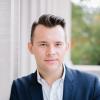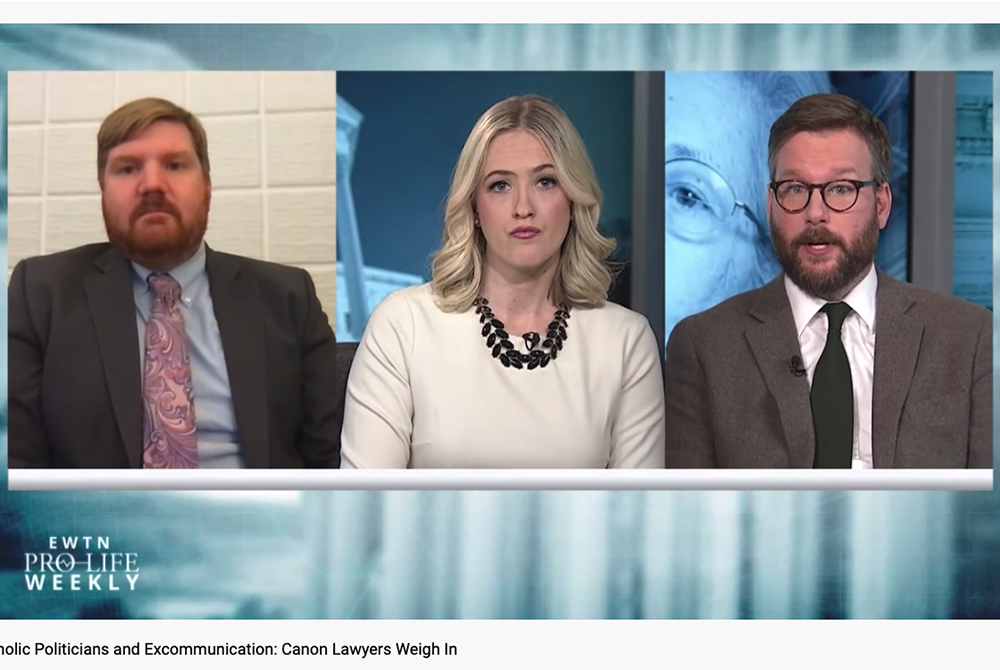
J.D. Flynn, left, then-editor-in-chief of Catholic News Agency, and Ed Condon, right, then-DC bureau chief for CNA, weigh in as canon lawyers on EWTN Pro-Life Weekly with Catherine Hadro in April 2019. (NCR screenshot/YouTube/EWTN)
Just hours after the announcement that a top official for the U.S. bishops' conference had suddenly resigned on July 20 citing "possible improper behavior," a newly launched Catholic media venture, The Pillar, published a nearly 3,000-word article alleging that the priest, Msgr. Jeffrey Burrill, had engaged in "serial sexual misconduct" by frequenting gay bars and using Grindr, a phone app for dating and sex.
The article was premised on an analysis of app data signals that the authors allege were "correlated to Burrill's mobile device." The signals, they write, "suggest he was at the same time engaged in serial and illicit sexual activity."
Missing in the story by The Pillar and in a subsequent response to questions about the ethics of the piece is the name of the vendor that provided the data, details about who paid to purchase the data and how it was obtained by the outlet, as well as any information on how the investigation was conducted to determine the signals were transmitted from Burrill's mobile phone. The story also lacked any confirmation of Burill's conduct beyond the location data.
The outlet has since published two subsequent articles alleging use of hookup apps within clerical residences in the Archdiocese of Newark, New Jersey, and in the Vatican.
Experts in journalistic ethics who spoke to NCR raised multiple concerns about The Pillar article.
"Ethically this is a softball. The article is scummy," Todd Gitlin, a professor of journalism at Columbia University's Journalism School, told NCR via email. "The hack using data tracking is illicit, indefensible, and all-around contrary to journalistic ethics."
"It's redolent of the depredations of [Rupert] Murdoch's News of the World busting into private phones," he added, referencing the enterprise's 2011 hacking scandal that led to the closure of the storied tabloid and millions of dollars of litigation after it was revealed that the publication hacked into the phones of politicians and celebrities.

A man types on a computer keyboard in this illustration photo. (CNS/Reuters/Kacper Pempel)
Although The Pillar article said there was "no evidence" to imply the priest had contact with minors, it went on to suggest that his possible consensual sexual behavior risked the possibility of clouding his judgment on the church's handling of the clergy sexual abuse crisis — another problematic leap, according to experts in journalistic ethics.
"The story casually links this case to others involving pedophile priests, but in fact, there is no evidence of that here," observed Bill Grueskin, a professor of professional practice at Columbia Journalism School.
"A good editor would have sussed out these issues, and likely eliminated the many references to unrelated cases that give the patina of criminal behavior to a situation that lacks evidence of such conduct," Grueskin told NCR via email.
Gitlin agreed: "The sneering references to pedophilia are nothing short of vile and McCarthyite," he concluded. "Roy Cohn would be proud."
Rick Edmonds, a media business analyst for the Poynter Institute, a nonprofit journalism school and research organization, told NCR, "The article raises a number of questions about cyber security and personal privacy and presents an alarming question of whether you can be tracked wherever you go."
Edmonds described the methods used by The Pillar as "unusual" and without any known journalistic precedent.
Flynn and Condon did not respond to NCR's requests for comment for this story.
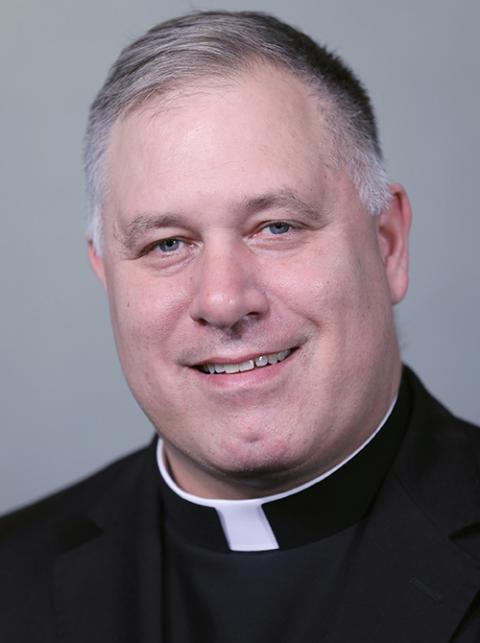
Msgr. Jeffrey Burrill, a priest of the Diocese of La Crosse, Wisconsin, is seen in this 2018 file photo. (CNS/Bob Roller)
(Editors of The Pillar have sought to compare their story to work by journalists at The New York Times to locate individuals for the Jan. 6 Capitol insurrection, although one of The New York Times reporters has noted that their reporting, on a criminal incident, only quoted the one individual who consented to being quoted.)
The outing of Burrill through questionable journalistic practices has sparked a contentious debate among many Catholics and for some, represents a stark departure from the "serious, responsible sober journalism about the Church, from the Church, and for the Church," that The Pillar pledged to provide when it launched on Jan. 4.
Yet while The Pillar's controversial reporting on Burrill has forced the new startup website into the national spotlight, a review of their past operations, connections of its top editors, along with undisclosed conflicts of interest and improper use of anonymous sources, reveals a history of questionable journalistic ethics.
Canon lawyers or journalists?
The Pillar was founded by its editor-in-chief J.D. Flynn and editor Ed Condon after the two resigned from EWTN-owned Catholic News Agency (CNA) in December.
At CNA, Flynn and Condon were at the helm of an agency that bills itself as being "one of the fastest-growing Catholic news providers in the world." During their tenure, the two would frequently boast of their independence from church hierarchy, their ability to uncover and report stories without fear or favor, and their accuracy and fair-mindedness in the process.
The two have also vowed to bring those same standards to their new operations. Yet while The Pillar has recently spilled considerable ink outlining allegations of sexual misconduct against one priest, including inferences of how his alleged behavior may have affected his judgment on matters related to sexual abuse of minors, their publications have not always disclosed their own professional involvement in clergy sexual abuse cases — not as journalists, but as legal advocates.
Both Flynn and Condon are canon lawyers. In a December 2020 podcast for the Catholic University of America (where Condon's wife works and his uncle, John Garvey, is president), Condon revealed that he continued to actively practice canon law while also working as a journalist covering the church.
After launching The Pillar, Flynn tweeted on Jan. 6 that the "left and right Catholic commentariat is lining up" to say that he and Condon are "canon lawyers not journalists."
"Meanwhile the two of us are breaking stories that make change while the chattering classes are pimping their increasingly irrelevant and partisan opinions," he wrote.
Among the most high-profile of church prelates to be accused of abuse in recent years is now-former Archbishop Anthony Apuron of Agana, Guam. In 2018, a Vatican tribunal found him guilty of abusing minors and sentenced him, resulting in his removal from public ministry.
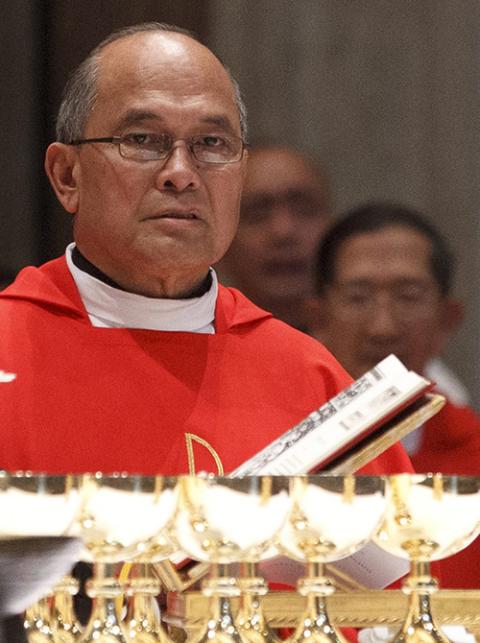
Now-former Archbishop Anthony Apuron of Agana, Guam, is pictured in a 2012 photo at the Vatican. (CNS/Paul Haring)
As is his canonical right, Apuron had canonical advocates who represented him while his case made its way through the church's judicial system. According to a source familiar with the trial and confirmed by a newspaper photo of the legal team, among his representatives was Condon, along with Judicial Vicar of the Archdiocese of Denver, Fr. Giovanni Capucci.
CNA's report about the trial — which carries a Flynn byline — refers to "sources close to the archbishop." Yet despite Condon's work as a canon lawyer on Apuron's case, CNA never disclosed this information.
Apuron, along with Capucci and Condon, are all members of the Neocatechumenal Way, a controversial movement that has spread throughout the world providing faith formation through small group communities.
Condon's involvement in the Neocatechumenal Way also was not disclosed during his coverage of another high-profile clergy abuse case, that of Australian Cardinal George Pell, who was tried for abusing minors, convicted and eventually exonerated by Australia's High Court, Condon was one of the most aggressive reporters covering the case and an open skeptic of Pell's guilt.
Pell has long been close with the Neocatechumenal Way, of which Condon and his extended family are a part of its leadership. In his prison memoir, Pell noted that "all the leadership of the Neocatechumenal Way, from around the world are interceding" for him.
Conflicts of interest — real or perceived
Avoiding conflicts of interest is a fundamental ethical concept for journalists. At the very least, journalists should "disclose unavoidable conflicts," as the Society for Professional Journalists' (SPJ) Code of Ethics states.
Veteran religion reporter and former Newsday editor Paul Moses gives the example of National Public Radio, which often reports on controversies concerning Amazon, one of its donors. "Any story about Amazon or its owner includes that Amazon is one of the nonprofit network's donors," he said.
Moses stresses that even perceived conflicts should be avoided.
"In teaching journalism ethics, I've often cited a quote from the late New York Times editor Abe Rosenthal, although in a cleaned up version: "You can sleep with an elephant if you want to, but if you do, you can't cover the circus," he said.
When The Pillar launched earlier this year, it did so via the online platform Substack, which includes a subscription model. But The Pillar has not disclosed its other sources of funding, nor has it outlined how it intends to avoid conflicts of interests.
"If the writers or editors at The Pillar are also currently practicing Catholic canon law, it's likely to conflict with the work they do in reporting on the Catholic Church," Moses observed. "At a minimum, those potential conflicts of interest need to be disclosed to readers."
"They may feel, and it may even be true, that their coverage is absolutely fair," he warned. "But it's also essential to avoid the appearance of a conflict of interest."
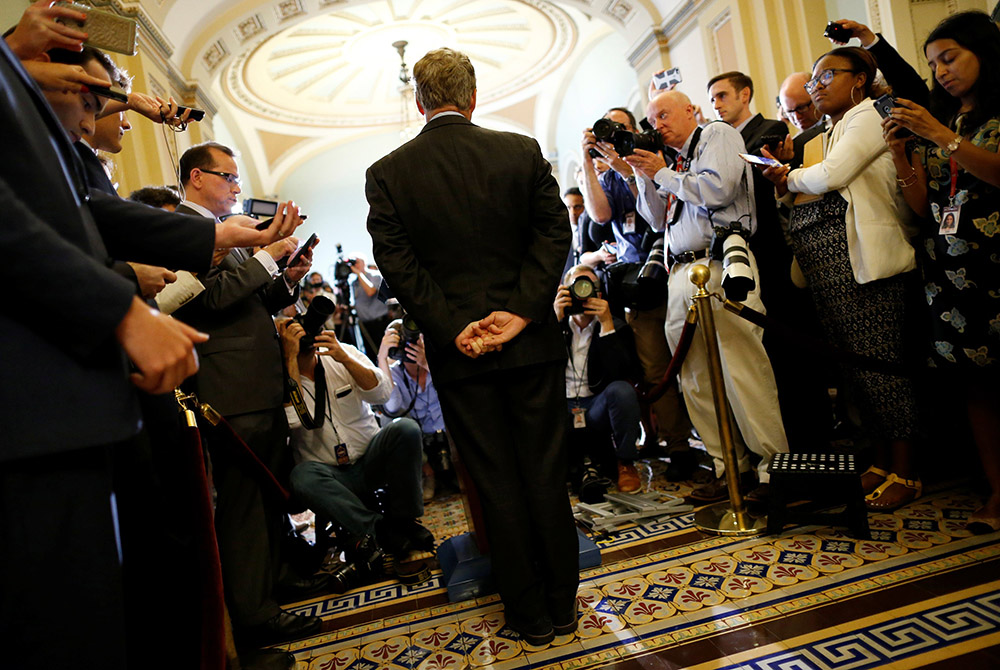
Journalists interview a U.S. senator in this illustration photo. (CNS/Reuters/Jonathan Ernst)
Both at CNA and at The Pillar, Flynn and Condon have touted their independence and transparency. When questioned on social media about CNA's treatment of certain church leaders, Flynn has been defensive.
"We are not 'bishop controlled,' bishop sponsored, bishop approved, or otherwise bishop connected," he recently replied in response to such criticism. Yet fawning treatment of bishops who share Flynn's ideological bent is common.
One month before Archbishop Charles Chaput reached 75 in 2019, the retirement age for Catholic bishops, Flynn published a gushing 2,000-word tribute to the man who gave him his first job in canon law and diocesan work.
"In the interest of full disclosure, I should make clear my own bias: I love Archbishop Chaput," he wrote.
"He has invested in my professional, intellectual, personal, and spiritual development. Some of the happiest years of my professional life were spent working for Chaput in the Archdiocese of Denver," Flynn continued.
Advertisement
Prior to being named editor-in-chief of CNA in 2017, Flynn also worked as a special assistant and communications director to Bishop James Conley of Lincoln, Nebraska. When it was announced that Conley was taking a leave of absence to focus on mental health, Flynn took to social media, writing, "Full journalistic disclosure: Bishop Conley is one of my best friends, and I'm praying for him, and proud of his decision to be so open about his mental health."
Flynn is also close to Denver Archbishop Samuel Aquila, having worked for the Archdiocese of Denver from 2007-13, which included serving as Aquila's chancellor during that time.
In April, The Pillar exposed a private disagreement between Aquila and Chicago Cardinal Blase Cupich, who had encouraged the Denver archbishop to provide a "public clarification" of comments made in an essay in America magazine arguing for so-called "eucharistic coherence" by denying the sacrament to those "persisting in grave sin."
Flynn did not disclose his previous relationship with Aquila in that report, nor does the report indicate how the private correspondence from Cupich was obtained.
Anonymous sources
Another core ethical principle for journalists involves the treatment of anonymous sources, which are occasionally necessary but can threaten accuracy and credibility. Anonymous sources are used regularly at the Pillar and at CNA under Flynn's leadership.
The Society of Professional Journalists' Code of Ethics recommends reserving anonymity for those "who may face danger, retribution or other harm, and have information that cannot be obtained elsewhere."
Journalists also should explain why anonymity was granted, the code says.
One controversial use of anonymous sources under Flynn's editorship at CNA involved the 2019-20 U.S. bishops' "ad limina" visit to Rome, which included a meeting between the pope and approximately a dozen bishops from the western region of the United States.
Flynn authored an article for CNA with two unnamed bishops who attended the meeting, alleging that Francis was displeased with some of the widespread and favorable coverage of a Sept. 2019 meeting with Jesuit Fr. James Martin, a prominent Catholic ally of the LGBTQ community.
"He was very expressive, both his words and his face — his anger was very clear, he felt he'd been used," one anonymous bishop told CNA. Among those present during that conversation was Flynn's former boss, Aquila.
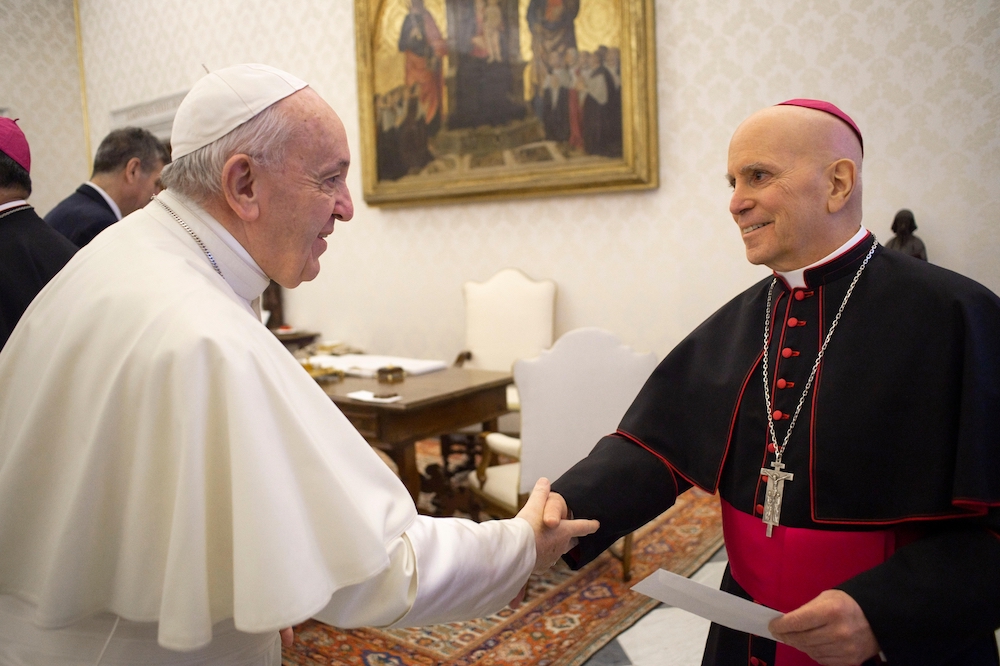
Pope Francis greets Archbishop Samuel Aquila of Denver, Colorado, during an audience with U.S. bishops making their "ad limina" visits to the Vatican Feb. 10, 2020. (CNS/Vatican Media)
(Francis has since sent Martin a letter reiterating his support of his work with LGBTQ Catholics.)
The CNA story — to which Condon contributed — did not include comment from any of the other bishops who attended the meeting, but after the CNA story was published two additional bishops went on the record contradicting Flynn's anonymous sources.
In an article published by NCR, Archbishop John Wester of Santa Fe, New Mexico, took the unusual step of challenging CNA's report.
"I believe that I have an obligation to offer my perspective on those matters contained in the CNA article about Father James Martin, SJ, since my understanding of the facts differs from what was reported anonymously," he wrote.
Following Wester's article, Bishop Steven Biegler of Cheyenne, Wyoming, also went on the record to note that Wester's response "accurately describes the tone and substance of the short dialogue regarding Fr. James Martin."
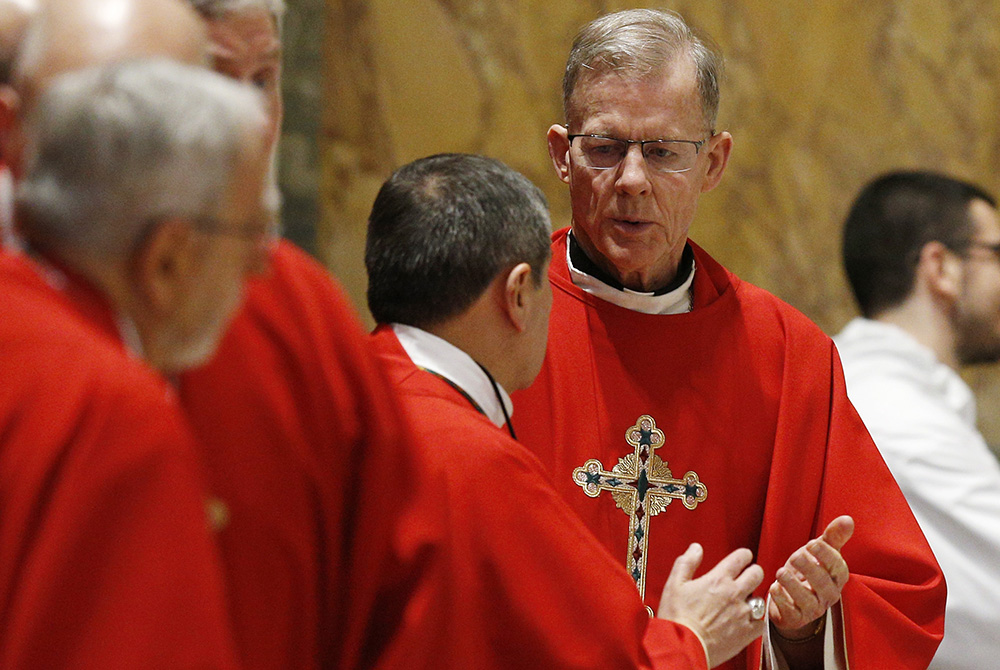
Archbishop John Wester of Santa Fe, New Mexico, offers the sign of peace as bishops from Arizona, Colorado, New Mexico, Utah and Wyoming concelebrate Mass at the Basilica of St. Paul Outside the Walls in Rome Feb. 12, 2020. The bishops were making their "ad limina" visits to the Vatican to report on the status of their dioceses. (CNS/Paul Haring)
After the incident, Deacon Greg Kandra, a veteran writer and producer for CBS, took CNA to task for their use of anonymous sources, noting that it failed to adhere to basic journalistic standards.
Kandra pointed out that Flynn's article did not explain why the sources were anonymous or their motivations. He also noted a lack of confirmation and that "CNA does not appear to have sought comment from the Holy See press office, or attempted to get someone to go on the record to confirm the account of this particular meeting."
"Whatever the full story may be, the one reported by CNA was incomplete and should have been more thoroughly vetted. Based on the published guidelines of the AP, the story would not have been published as it was by the Associated Press (or a lot of other news operations)," Kandra wrote. "In fact, it should not have been published as it was by CNA."
Although there are instances in which journalists use and protect anonymous sources, the SPJ Code of Ethics states that generally "the public is entitled to as much information as possible to judge the reliability and motivations of sources."
After The Pillar's piece outing Burrill — and despite numerous calls for more transparency about the acquisition of the cell phone app data — Flynn and Condon continued to decline to name the specific dataset they, or someone else, purchased, or the methodology used in de-anonymizing it.
Last week Kandra again took to his popular blog to share an analysis about the controversy, from — ironically — Catholic News Agency, which had announced the day before The Pillar story that it had declined a previous offer of the app data in 2018.
"The end never justifies the means, even if they are digital and seem credible because of technology," said William Thorn, associate professor emeritus of journalism and media studies at the Institute for Catholic Media at Marquette University's Diederich College of Communication, in an interview with CNA's executive director Alejandro Bermudez.
Despite widespread criticism of The Pillar's methods and journalistic practices, the outlet appears to be continuing to use the data for two follow-up stories about the Archdiocese of Newark and the Vatican.
Michael Murphy, director of the Hank Center for the Catholic Intellectual Heritage at Loyola University Chicago, took to Twitter to express his own exasperation at the latest.
"Flynn and Condon practiced second rate journalism at CNA — with some pretty questionable approaches to research and investigation," he wrote. "The pattern continues."
"And caveat lector," he concluded, using the Latin expression: "let the reader beware."
